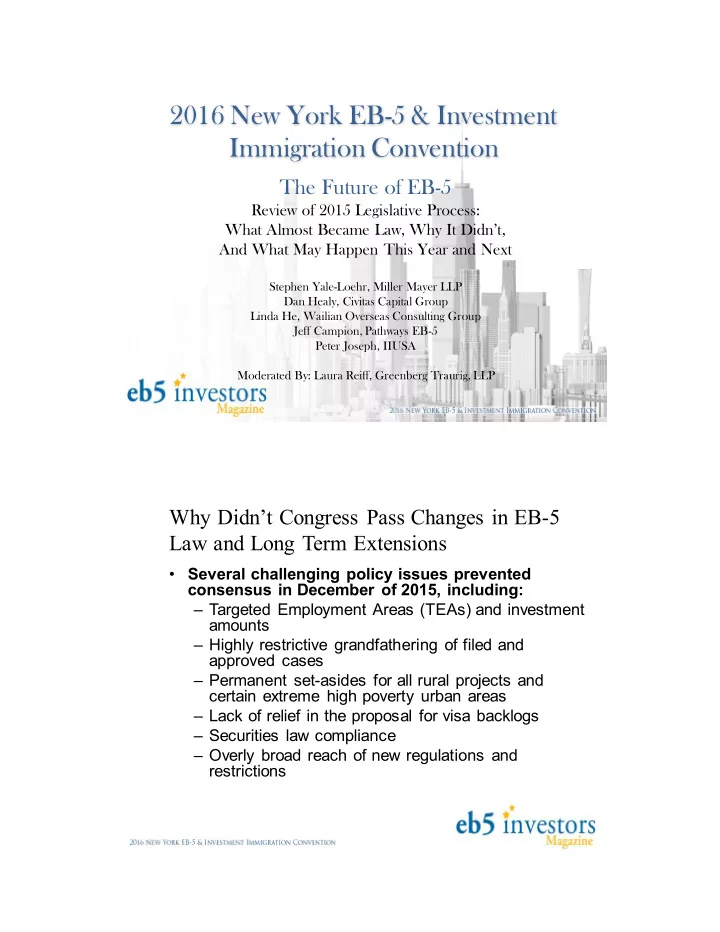

2016 New York EB-5 & Investment Immigration Convention The Future of EB-5 Review of 2015 Legislative Process: What Almost Became Law, Why It Didn’t, And What May Happen This Year and Next Stephen Yale-Loehr, Miller Mayer LLP Dan Healy, Civitas Capital Group Linda He, Wailian Overseas Consulting Group Jeff Campion, Pathways EB-5 Peter Joseph, IIUSA Moderated By: Laura Reiff, Greenberg Traurig, LLP Why Didn’t Congress Pass Changes in EB -5 Law and Long Term Extensions • Several challenging policy issues prevented consensus in December of 2015, including: – Targeted Employment Areas (TEAs) and investment amounts – Highly restrictive grandfathering of filed and approved cases – Permanent set-asides for all rural projects and certain extreme high poverty urban areas – Lack of relief in the proposal for visa backlogs – Securities law compliance – Overly broad reach of new regulations and restrictions
Why Didn’t Congress Pass Changes in EB -5 Law and Long Term Extensions? (cont.) • Senators and Representatives could not agree on a final reform bill before the December deadline for the Federal spending bill • The bill that was being negotiated at that time was very complicated, and some Members of Congress believed that more time was needed to make sure all provisions in the bill would work correctly • Between now and September 30, 2016, Senators and Representatives must agree on legislation to reauthorize the EB-5 program • The EB-5 industry will play an important role working with lawmakers to ensure that EB-5 legislation protects investors, is fair, and works for project developers Some Areas of Industry Agreement • Investment amount increase Tip: File now for lower amount • Long term extension – 5 years • Integrity measures to protect investors and prevent misconduct (pending industry-recommended modifications)
Joint EB-5 Industry Letter Sent to Congress What Is Likely To Happen In 2016…or 2017? • 7 EB-5 bills are pending in Congress • The Senate and House Judiciary Committees have held three EB-5 hearings so far this year; more are expected • USCIS is working on revised EB-5 regulations • Because 2016 is a presidential election year, the legislative schedule in Congress is compressed • Short term extension by September 30, 2016 is possible but we may also see a larger reform bill • But it is very difficult to accurately predict future congressional action in light of current general political dynamics and presidential election • Addressing backlogs and quota limitations must be a priority – Legislation – Administrative action – Legal action in federal court • With any reform legislation, there will be substantive law changes
What Is Likely To Happen In 2016…or 2017? (cont.) • Policies the industry and investors will likely confront in any legislation: – Integrity-related provisions – Increase in investment amount (could also be in regulations) – Change in TEA procedure and definition (could also be in regulations) – 10% direct jobs requirement or other changes to indirect job creation rules – Visa set-asides for certain areas – Grandfathering, or lack thereof, of existing projects and petitions – Potential retroactive application of new rules to projects or investors – New rules for gifts – New rules for loans What Is Likely To Happen In 2016…or 2017? (cont.) • Policies the industry would favor in any legislation: – Integrity-related provisions (with industry input) • Protection of investors • Long-term viability of the program – Backlog reduction and quota relief – Expansion of program capacity — additional visa numbers through recapture or exemption of derivatives from the cap – No retroactive application of new rules to current investors or projects – Reasonable and fair grandfathering rules for pending and approved projects – Reasonable investment differential between TEA and non- TEA projects
The Future of EB-5 – Has the Bubble Burst? • Competition from other countries • Uncertainty of U.S. EB-5 program • Unwieldy Visa Backlogs • Continued Enforcement Actions • Agency Delays in Processing • Chinese Investors? Are they still interested in EB-5 Possible Administrative Actions • Revise source of funds rules • Introduce stricter Regional Center termination provisions • Raise investment amount • Increase site visits to Regional Centers • Increase cooperation with U.S. State Department on the ground overseas • Increase cooperation with SEC to prevent fraud and securities violations
QUESTIONS Disclaimer This presentation outline and the presentation itself are for general education purposes only and are not intended to provide specific guidance or legal advice about what to do or not to do in any particular case. You should not rely on this general information to make decisions about specific immigration matters. If you are not yourself a lawyer, you should seek the assistance of an immigration lawyer to help you resolve these issues. Thank you.
Recommend
More recommend